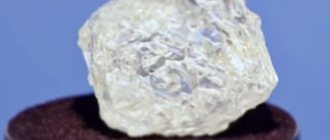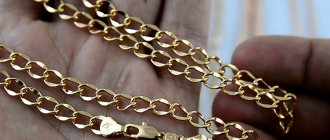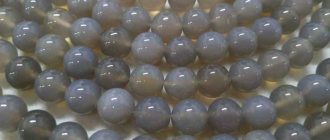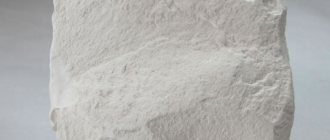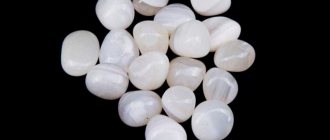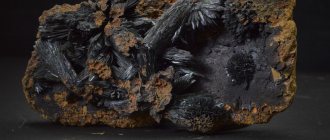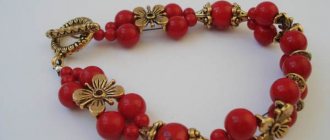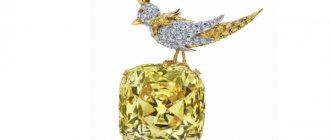- Color: red, pink, white (black, blue).
- Hardness: 3–4 points.
- Density: 2.6–2.7 g/cm³.
Corals (Greek, original meaning unknown) form reefs, atolls and coral shoals in tropical seas with intricately branching bushes - colonies of polyps. Only the calcareous frames (external skeletons) of these colonies are used as material for jewelry stones - corals. Such a framework (polypnyak) is built by many small polyps, which are located in tiny cells - recesses of the exoskeleton - and secrete lime with their lower ends to form plantar plates. The height of the colonies is 20–40 cm, the thickness of their branches reaches 6 cm.
Colors
In jewelry, the red Corallicum rubrum, or Corallicum nobile, is most valued among all types of corals. The entire colony has a skeleton of one, usually uniform, color, but from colony to colony its shades vary from soft pink to dark red, the color of ox's blood. Only sometimes corals have white or pale pink spots.
Along with red and pink corals, white, black and blue corals are processed. White corals, like red ones, are composed of carbonated lime, but black and blue ones are made of the organic horny substance conchiolin with a density of 1.34–1.46 g/cm³. Colonies of black corals reach a height of 3 m.
Carmine-red corals are considered especially valuable, giving the color “coral” its name. Bright red specimens of good quality are quite rare. More often it can be warm red shades or salmon color. Pink corals stand somewhat apart. Their delicate color is valued by true connoisseurs on a par with scarlet. The French call these light, almost creamy shades peau d'ange, that is, “angel skin.”
Corals are sensitive to heat, acids and hot baths! When worn, they may fade or become pale.
Deposits and production Corals are distributed along the coast of the Western Mediterranean and the Bay of Biscay, the Canary Islands, the Malay Archipelago, and Japan. Black corals are mined in the Malay Archipelago, Northern Australia, and the Red Sea.
Colonies of coral polyps are located at a depth of 3 to 300 m from the sea surface. They are caught using weighted, large-mesh nets that are dragged along the seabed, tearing off the polypnyaks attached to it with a wide base from the rocky soil. At the same time, a lot of valuable material deteriorates and perishes. The caught corals are cleaned of soft tissue and sorted.
Quality and processing Coral is processed in cabochons or in irregular (natural) shapes. It is sometimes cut into a round shape for use in beads.
High-quality coral beads should be free of chips, cracks and holes. But since coral is a rather soft and porous material, it is often strengthened when making jewelry. The beads are impregnated with colored wax and tinted. When black corals are bleached, they produce sprigs of a beautiful golden color.
Beautiful coral jewelry
Coral is one of the most ancient materials used in jewelry by craftsmen. At its core, coral is an organogenic mineral consisting of calcite with an admixture of magnesium carbonate and aragonite.
It represents the exoskeletons of modern invertebrate marine animals.
Corals belong to the class Cnidaria, or cnidarians, which includes about 10 thousand species, including hydroids, jellyfish, sea anemones and gorgonians.
The fashion for coral jewelry has lived and flourished for more than two thousand years. In medieval Rus', coral was often used as a material for inlay. In the European Renaissance, there was a tradition of coral carving, which has now, unfortunately, almost disappeared. The popularity of coral in Far Eastern cultures is the highest among other peoples in the world.
In the East they believe that coral brings happiness. Coral beads were revered by different peoples as a talisman against the “evil eye.” In Portugal they still believe that wearing red coral beads helps get rid of headaches. In England they treat sore throat, and in Mexico they treat fever. In the legends of Kyrgyzstan, Uzbekistan and Tajikistan, it was believed that coral brings wealth and large families, carnelian brings prosperity, joy and abundance, and turquoise bestows victory. Therefore, the combination of red (ruby, carnelian, coral), blue and green (turquoise) has become traditional in oriental jewelry
Modern science knows about 25 types of corals that are suitable for subsequent processing and making jewelry. But it's not just red corals. In the fifties of the last century, black corals were discovered off the Hawaiian Islands.
There, and later in the Philippines, golden coral or cream coral was found. And just recently, purple corals were discovered.
And yet, with such an abundance of colors, jewelers mainly work with red corals and its various shades.
The Corallium species includes many different types of coral, of which only 5 are processed and used for jewelry.
There are over 2,500 varieties of corals known in nature, with up to 350 different color shades. Ferrous compounds color the coral in red, orange, pink and brown tones, and manganese compounds – gray.
Blue and blue corals (akori), as well as black (akabar) are considered very rare.
Black coral.
Exceptionally rare blue coral (akori). Black and gold corals are fashionable, blue ones are very rare and expensive. Pale pink is also considered a very expensive color - a variety of “angel skin”. Famous and beloved are the rich red Japanese “Moro Corals”, pale pink “Bokeh” and red “Sardena”.
In ancient times they said that coral makes its owner wiser, promotes the development of logic and intuition. It was also believed that corals are very helpful in matters of the heart - jewelry with it guarantees the owner success with the opposite sex. The most valuable part is the top of the coral branches.
The best quality corals have a matte shine, on polished surfaces it is glassy, and sometimes greasy when broken.
CORAL – the name comes from the Greek “unknown”. Formed in connection with the life activity of colonial polyps.
Corals form tree-like structures with an average branch diameter of 4–6 mm, making up reefs and atolls.
The composition includes calcite, the organic substance conchiolin and other substances.
Conchiolin predominates in black and blue corals. Blue coral.
Corals can be opaque and translucent in thin chips.
Color pink, flesh pink, red, dark red, white, rarely bluish, black. The gloss is matte, on polished surfaces it is glassy, and sometimes greasy at break.
The properties of corals depend on the ratio of mineral and organic matter. Fragile. The fracture is conchoidal. It has been used in jewelry since ancient times in beads, rings, cameos, brooches and other jewelry.
It is also used as an ornamental stone.
It is found in warm seas at a depth of 3 – 200 m. The growth rate of coral is 75 mm per year.
Fishing places: Mediterranean Sea - the coast of Tunisia, the Red Sea, the coast of Algeria, Sardinia, Italy, Sicily, Morocco and others. Noble coral (red coral): Corallium rubrum Noble coral, or red coral (Latin Corallium rubrum) is a species of coral polyps from the order Gorgonacea.
Painted with organic pigment in red or pink, occasionally blue and black. The color of a coral depends on its organic matter content, light exposure, and impurities captured during growth. It lives at a depth of 10-200 meters in the Mediterranean Sea (off the coast of Italy, Algeria, Tunisia, Morocco), the Red Sea, off the coast of Japan, Malaysia, Australia, and in the Hawaiian Islands. It forms branched colonies that are firmly attached to rocky soil. The polyps are white, equipped with a corolla of 8 feathery tentacles. Red corals take the form of small leafless shrubs and can grow up to a meter in height.
Corals are usually extracted from the sea by divers and divers using nets and rakes.
They hunt them for six spring-summer months; with the onset of storms, work stops. Since ancient times, red corals have been used in the production of various jewelry: beads and necklaces, rings, rings and signets. Red corals are used to make jewelry and are more valuable than other types of coral. Red corals have been used for jewelry and have been highly prized since ancient times. Since ancient times, it was believed that red coral is the center of three natural elements: water, earth and fire. It controls (regulates) body temperature, metabolism, digestion and skin, and has a good effect on the thyroid gland. Neutralizes negative phenomena - envy, irritability. Rare pink coral - “angel skin”.
In Rus', red coral was called “Korolek”.
In the 13th-18th centuries, it was widely used in jewelry and to decorate the clothes of representatives of the rich classes. The main color varieties of noble coral are:
Coral of a dark brownish-red color is called “ox blood”.
The rarest and most expensive type of noble coral is the scarlet “Sardinian coral”. An orange-red coral close to the salmon color is “salmon”. Angel Skin is a pale pink coral. Rules for caring for coral jewelry
Coral reacts to high temperatures and is sensitive to acids, so these influences can change the color of the stone, which has given rise to the belief that coral jewelry worn on a sick body will discolor. Coral tradition and fashion
In some regions, there was a tradition of placing red coral beads around the necks of small children. Also, such beads are given to young girls as their first decoration. They have a beneficial effect on the skin and are very decorative.
Coral is valued mainly for its color. The most expensive coral is considered to be light pink, flesh-colored (angel skin); behind it is orange-red, - red polished coral is valued on a par with silver.
Fashion also plays a big role in cost. Prices for noble corals on the world market have risen significantly, and the high demand for products made from pink and red corals is explained both by its jewelry values and the magical properties attributed to it.
Coral treatment
Today, coral calcium is well known and popular - for enriching water and providing essential calcium. Coral is a source of protoglandin hormones, affects the metabolism of proteins in the body, causing the proper functioning of the muscles of the digestive and respiratory systems, uterine muscles and smooth muscles. So coral is also taken orally.
Avicenna (980-1037) pointed out that coral has long been used as a medicine for the eyes. A red coral necklace is believed to heal wounds and bleeding. This stone helps as a preventative against coughs and flu, and can be used as a warming agent in combination with warm clothing and a blanket. In winter, it is recommended to wear a coral necklace all the time, especially for those who are “freezing” :-). Coral is also recommended for singers, lecturers and all professions where a person works with the voice; it is good for anemia and asthma. In combination with pearls, coral normalizes the menstrual cycle and is believed to treat infertility.
Corals at a wedding 35 years of marriage - this is a coral wedding!
35 years of marriage is an achievement and deserves to be celebrated in a special way.
Decorations with corals are a necessary attribute of the holiday here.
Coral is also a wonderful wedding decoration for the bride: you can choose red, pink, or white coral, depending on the style, color and decoration of the dress. The dress can even be embroidered with corals - stunningly impressive.
Coral jewelry is resistant to mechanical stress and high temperatures.
In addition, corals lose color intensity over time, i.e. fade.
However, if faded coral is briefly immersed in a hydrogen peroxide solution, the original color will return.
CORAL JEWELRY - COLOR GRADATION
There are the following types of corals depending on their color:
- akori - a species of coral that has shades of blue and purple tones, growing off the coast of Africa and the Samoan islands;
- Akkabar – black coral;
- "Moro" - a variety of bright red corals that grows off the coast of Japan;
- “Boke” – varieties of corals of pale pink shades from the coast of Japan;
- heliopore (“sun coral”) is a type of coral that has a cobalt blue color that fades in the sun;
- “ox blood” is a type of coral with brownish-red tones;
- sardena is a type of noble coral with a scarlet color tone;
- Salmon is a type of coral that has a pinkish-orange range of tones;
- “angel skin” is a type of coral that has pale pink shades, close to flesh tones, with a silvery-pearl sheen;
- bianco – white coral;
- “golden” - corals from the shores of the Hawaiian Islands that have a golden hue;
Source
Coral analogues
Synthetic Gilson coral and colored bambu coraloid can be classified as coral analogues. And various materials are counterfeited - from plastic to ceramics.
How to distinguish real coral from fake Coral is synthesized in various ways. The main thing is that the synthesized material is as similar as possible to the original. Most often, only a specialist can distinguish synthetic coral from real coral. Upgrading coral usually comes down to impregnation (filling cracks), including with dyes.
The simplest fakes and imitations: plastic, glass, porcelain, bone, polymer clay, synthetic Gilson coral, pressed chips. For example, a glass imitation will give itself away immediately: if you see small bubbles, this is a fake. Real coral can be easily distinguished from plastic using a heated needle: the plastic will begin to melt and a black dot will appear at the heating site; nothing will happen to the natural sample.
How else can you determine authenticity? Natural coral, unlike fake coral, has an amazing pattern reminiscent of growth rings on trees.
The color of synthetic Gilson coral, created from calcite powder with silica, will be very even and evenly distributed over the entire surface. In addition, synthetics are denser and do not have a pattern. Whereas real coral always has color transitions and a characteristic mesh pattern, similar to the texture of a wood cut. It's easy to see under a magnifying glass.
You can identify fake polymer clay and porcelain at home by dropping one drop of a weak vinegar solution onto the sample. A real coral, consisting of calcite with impurities, will begin to react to alkali; a fake of inorganic origin will not react with vinegar.
To determine whether a sample has been colored, you need to immerse it in plain water for 2 hours and see if its color changes. Common and inexpensive white corals are most often used for tinting. Natural coral will never stain water, and painted imitations may even leave marks on the skin in the heat.
If we talk about coral beads and necklaces, then you should pay attention to the holes in the beads: when drilling, microcracks remain in natural coral.
Coral: gifted by the sea
Coral is one of the very first materials that man began to use as decoration. Coral framed with gold or silver was found during excavations of ancient cities. Why has this stone remained so popular for so many centuries?
What is coral
Most often, coral is called a stone, but this is not entirely true. It has nothing in common with the classic minerals that we are used to seeing in jewelry. Like pearls, they are born in water and are the fine-grained, calcareous skeletons of coral polyps, invertebrate creatures that live in salt waters.
They build this skeleton to protect themselves. Typically, polyps live in colonies and gradually form beautiful coral reefs.
Types of corals
There are several hundred species of corals in nature. Only 27 of them can be processed and only 7 are used in the jewelry industry. They are opaque and only show through at the edges.
Each coral has its own unique color. In international practice, the Italian shade scale is used, in which the varieties have their own name.
"Bianco" - white and mother-of-pearl corals, "pelle d'angelo", or "angel skin" - a valuable species that has a delicate flesh-pink or slightly silvery tint. Pale pink corals are called “rosa pallida”, bright pink ones are called “rosa vivo”, orange-pink (salmon colors) are called “secondo coloro”. The prized dark red corals are “rosso scuro”, while the purplish red ones are known as “arciscuro carbonetto”, or “ox blood”.
Just like most mineral formations, their shade depends on lighting, organic substances and additional components. Thus, iron gives corals an orange-pink to brown color, and a high content of manganese gives them a gray color.
According to quality, they distinguish African, Algerian, Mediterranean (which include, in particular, Italian), Spanish, Hawaiian and Japanese corals. It is clear that all names are associated with the places of extraction and processing of this valuable natural material.
Habitat
The depth of coral habitat can reach 1000 m. The deeper the reef is located, the faster it grows. The most popular red corals live in warm seas at depths of 30 to 500 meters and grow 75 mm per year.
Corals are mined in the Mediterranean, Red and Caribbean seas, on the coasts of the Atlantic, Pacific and Indian oceans. They are pulled out with large nets, literally tearing off part of the reef and dragging along the seabed. In this case, a sufficient amount of valuable material is spoiled.
Currently, coral is processed mainly in Japan, Taiwan, Hong Kong and India.
Refinement and synthesis
To restore the faded shade of coral, it is treated with hydrogen peroxide.
In 1972, the Gilson company in Switzerland for the first time received synthetic coral, which became known as “Gilson coral.” Using synthesis, 12 different shades of inserts were obtained. The properties of synthetic corals are close to natural ones, with the exception of lower density - 2.6-2.7 instead of 3-4 on the Mohs scale.
Coral fashion
In fact, corals have not gone out of fashion for over two thousand years. They were inlaid with belts, women's combs and hair accessories, weapon handles and cult items. Thus, in Rus', corals were called “kings” and were used not only in jewelry, but also to decorate clothes. Ancient finds of this stone were discovered on the Don.
Coral has long been mined and processed in Italy; it was popular in France. In Europe, there was even the art of coral carving.
Now it is used both in gold jewelry and in more affordable models made of silver. Jewelers often combine coral with semi-precious stones, such as garnet or rauchtopaz.
It is possible to emphasize the vintage charm of semi-precious stones using cabochon cutting. Perfectly smooth inserts look even brighter and more attractive and immerse you in the atmosphere of the amazing underwater world.
Coral in astrology and its magical properties
Coral is considered a talisman for travelers. This stone is suitable for passionate and emotional natures. They believe that jewelry with coral makes its owner more attractive to the opposite sex and fills it with confidence. He is able to revive cooled feelings and rekindle love. Earrings or beads with red corals awaken energy in a person, relieve lethargy and apathy.
Pink coral brings happiness, helps to build a new life, makes the owner softer and more feminine, while white coral harmonizes.
It is recommended to wear such jewelry for zodiac signs such as Pisces, Capricorn and Scorpio. But coral is not contraindicated for other signs either.
Related materials:
Editor's Choice: September | Jewelry ABC | Leighton Meester | massive jewelry | corals | Zodiac sign | Heidi Klum | Dior | women's jewelry | Famous women | Red Sea | Red color | appearance | yellow color | Cartier | Rus | coral | Oscar | Heidi Klum
Articles
- Stars in vests July 30, 2012, 19:00
- Jewelry ABC: aquamarine May 09, 2013, 18:00
- Jewelry ABC: turquoise June 07, 2013, 19:00
Video
- Roadster by Cartier 03 December 2008, 12:10
- Cartier Baiser Volé November 11, 2011, 00:34
- Dior Addict Eau Délice - a new women's fragrance from Dior June 24, 2013, 12:00

